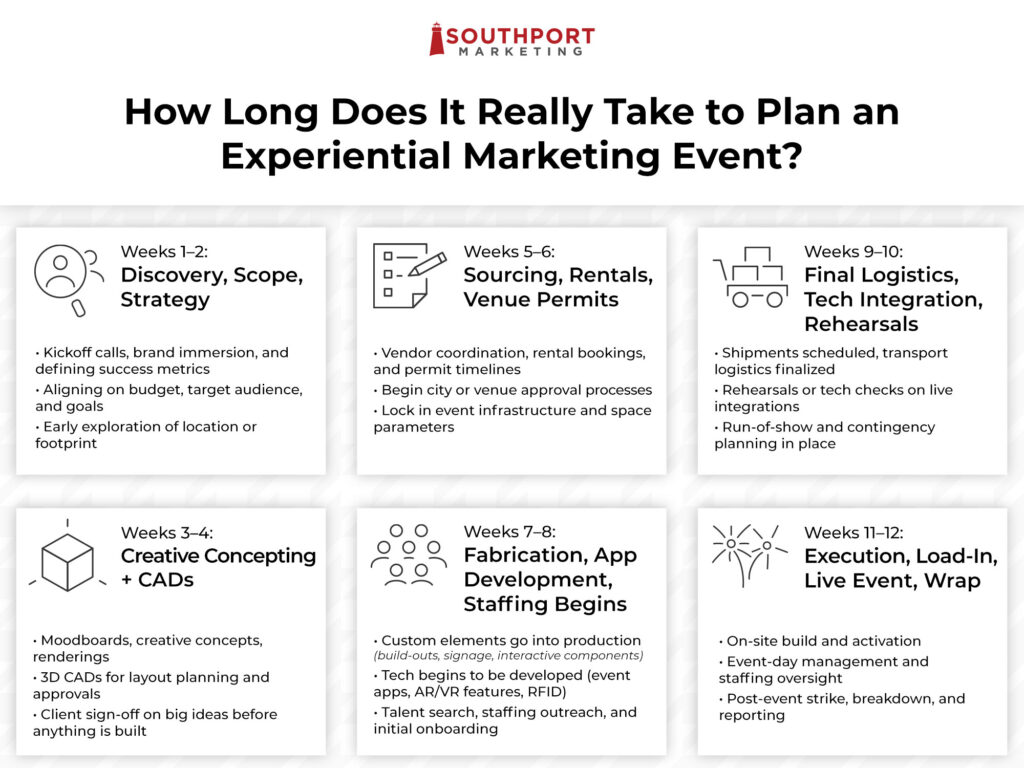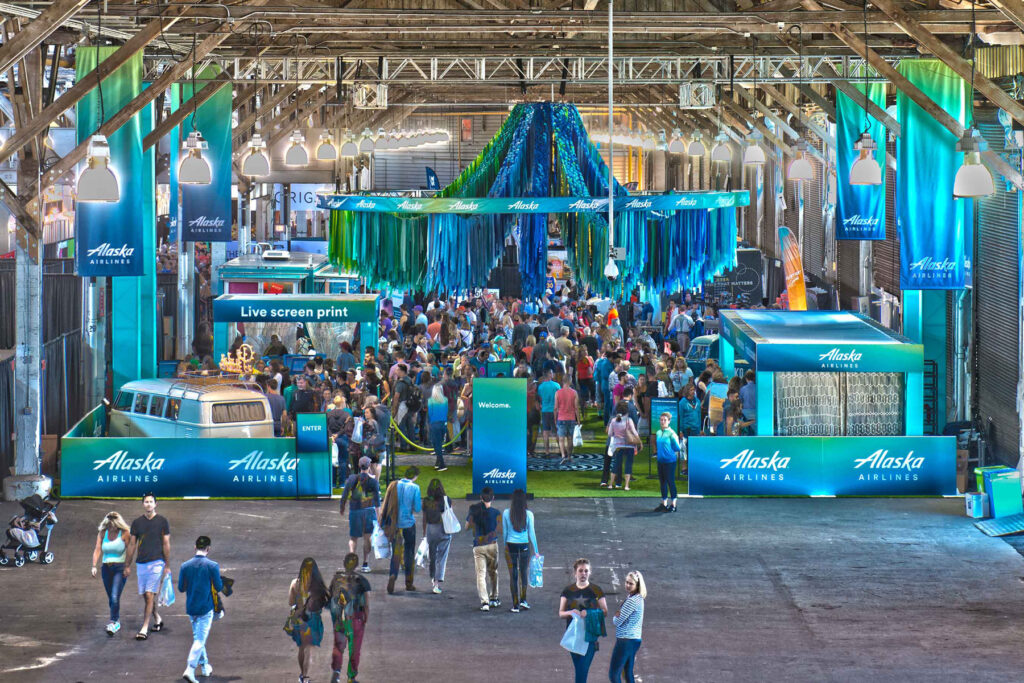Event Planning Gap
Somewhere out there, a marketing lead is pitching a killer idea to their team: a rooftop pop-up, a brand tunnel experience, maybe a fully immersive product launch. Everyone’s in… until someone asks, “How soon can we make this happen?”
That’s where the reality check kicks in.
Here at Southport Marketing, we’ve had clients come to us with amazing concepts and just two to three weeks to bring them to life. While we admire the energy, experiential marketing doesn’t work like flipping a switch. These are high-touch, logistically layered productions. And yes, they take time.
This post is here to set the record straight. You’ll get a clear picture of how long experiential events really take to plan, what happens at each stage, and how to give your event the time it needs to actually shine. Whether you’re launching a new product, engaging fans at a major festival, or rolling out a national tour, understanding the timeline is the key to doing it right, not just doing it fast.
Ideal Event Production Timeline (Week-by-Week Breakdown)
Experiential events aren’t plug-and-play. They’re custom-built brand moments that require strategy, storytelling, and logistics. Here’s how the timeline usually unfolds:
Weeks 1–2: Discovery, Scope, Strategy
- Kickoff calls, brand immersion, and defining success metrics
- Aligning on budget, target audience, and goals
- Early exploration of location or footprint
Weeks 3–4: Creative Concepting + CADs
- Moodboards, creative concepts, renderings
- 3D CADs for layout planning and approvals
- Client sign-off on big ideas before anything is built
Weeks 5–6: Sourcing, Rentals, Venue Permits
- Vendor coordination, rental bookings, and permit timelines
- Begin city or venue approval processes
- Lock in event infrastructure and space parameters
Weeks 7–8: Fabrication, App Development, Staffing Begins
- Custom elements go into production (build-outs, signage, interactive components)
- Tech begins to be developed (event apps, AR/VR features, RFID)
- Talent search, staffing outreach, and initial onboarding
Weeks 9–10: Final Logistics, Tech Integration, Rehearsals
- Shipments scheduled, transport logistics finalized
- Rehearsals or tech checks on live integrations
- Run-of-show and contingency planning in place
Weeks 11–12: Execution, Load-In, Live Event, Wrap
- On-site build and activation
- Event-day management and staffing oversight
- Post-event strike, breakdown, and reporting
Of course, not every project needs 12 weeks of lead time. But shorter timelines almost always mean fewer options and tighter margins for error.
What Can Shrink or Stretch the Event Production Timeline?
There’s no one-size-fits-all formula. Every event has moving parts and sometimes, moving deadlines. Here’s what affects the clock:
- Budget Approvals: Delays in internal sign-off ripple into every phase.
- Venue Permits & Approvals: Some cities (looking at you, LA) need 30-plus days for paperwork.
- Custom Builds vs Rentals: Fabricating a branded shipping container is not the same as booking folding tables.
- Talent & Staffing Scale: National tours, bilingual teams, or celebrity tie-ins require more time.
- Event Size or Footprint: A 10×10 booth? Faster. A 10-city mobile tour? Start yesterday.
Just because it’s a one-day event doesn’t mean it takes one week to plan.
Why Southport Streamlines It Better
Most agencies outsource half their process, then spend extra time managing vendors who don’t talk to each other. Southport does it differently.
Here’s why:
- 90% of our services are delivered in-house, including staffing, fabrication, fulfillment, app development, and warehousing
- Fewer vendors means fewer delays and faster creative-to-execution handoffs
- Creative and production teams work under the same roof, not across time zones
- Real-time updates and decision-making keep the momentum up, not stalled
“We don’t just dream it up. We build it, staff it, ship it, and show up with it.”
Even with our integrated structure, though, planning an event still takes time. We can move fast, but your event deserves more than a rush job.
What Happens When You Wait Too Long to Plan an Event?
It’s tempting to assume it’ll all come together. But waiting too long to kick off planning creates unnecessary friction. Here’s what we’ve seen firsthand:
- Rush fees on fabrication, permits, shipping, and labor
- Venue limitations if your dream location is already booked
- Talent availability shrinks the closer you get to activation
- Creative compromises become inevitable when time disappears
- Stress goes up for your team and ours
You might still get the event, but it won’t be the one you imagined.
Start Early, Launch Smarter
We’ve found that the sweet spot for planning most full-scale activations is 10 to 12 weeks. It gives us space to get creative, time to build, and room to solve problems before they hit the stage.
And don’t worry. We’ll walk you through every step. Whether this is your first time planning an event or your fiftieth, our production team brings the same energy, organization, and operational power to every brand moment we produce.
Let’s bring your brand to life, the right way.
Reach out early, and we’ll help map the event production timeline from daydream to showtime. You’ll get more creative freedom, fewer compromises, and a team that’s all in from day one. Because when the event planning starts early, the experience hits harder. Get started today!


